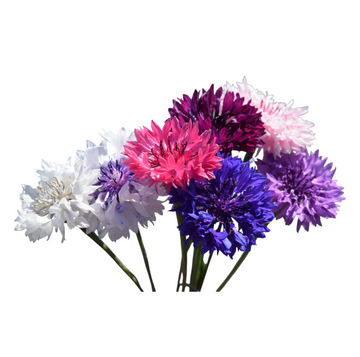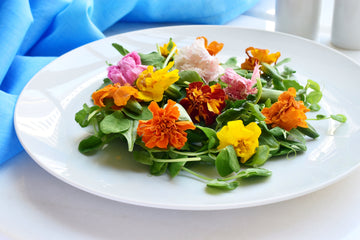Mixed-Color Bachelor Button Flower

Freshly Harvested

Non-GMO & Natural

Nutrient Dense

Trusted by Chefs
25 Seeds+
🌸 Mixed-Color Bachelor Button Flower Seeds
Centaurea cyanus
A cottage garden classic with a rainbow twist 🌿🌈, Mixed-Color Bachelor Buttons bloom in a cheerful palette of blue 💙, pink 💗, white 🤍, lavender 💜, and deep burgundy ❤️. Hardy, drought-tolerant, and endlessly floriferous, these heirloom beauties bring old-world charm to gardens and gourmet plating alike. Their mild clove-like flavor makes them a chef’s favorite edible garnish for baked goods, cocktails, and salads.
👅 Flavor Profile:
Mildly sweet 🍯, clove-spiced 🌿, with earthy undertones 🌱.
🍴 Culinary Uses:
🥗 Sprinkle petals over salads for bursts of color
🧁 Decorate cakes, cookies & pastries with jewel-like blooms
🍸 Float blossoms in cocktails or freeze into ice cubes for rainbow flair
🍵 Brew into teas or syrups for a gentle floral infusion
🍫 Pair with chocolates & custards for a vibrant contrast
👨🍳 Chef’s Pitch:
Mixed-Color Bachelor Buttons are the chef’s rainbow garnish 🌸👨🍳🌈. With jewel-toned petals and subtle floral flavor, they turn simple desserts, cocktails, and salads into edible art. Hardy, prolific, and endlessly charming, they’re the perfect crossover of heritage flower + gourmet ingredient.
🌱 Growing Notes:
🪴 Annual, 24–36” tall, upright and branching
🌸 Blooms in blue, pink, white, lavender & burgundy
🌞 Thrives in full sun, drought-tolerant & easy to grow
🐝 Pollinator-friendly, attracts bees & butterflies
🌿 Excellent cut flower with long vase life
✨ Quick Facts:
-
Latin Name: Centaurea cyanus (‘Mixed Colors’)
-
Habit: Annual, 24–36” tall
-
Flavor: Mildly sweet, clove-like, earthy
-
Culinary Uses: Garnishes, cakes, cocktails, teas
-
Special Use: Multicolored edible blooms + cut flowers

Mixed-Color Bachelor Button Flower

Let’s Manifest Beauty.
Edible Flowers that Smile.
Edible flowers are more than just decoration — they’re a chef’s secret for adding elegance, fragrance, and subtle flavor to a dish. From citrusy marigolds to honey-sweet alyssum and tangy begonias, these delicate blooms transform plates into experiences. Each petal offers color, aroma, and taste, turning simple ingredients into a culinary statement.

Flowers are here to stay
The Art of Garnishing with Edible Flowers
A garnish should do more than decorate — it should enhance. Edible flowers bring color, fragrance, and subtle flavor to the plate, turning simple dishes into memorable experiences. From delicate petals scattered across a salad to a single bloom crowning a dessert, flowers add elegance and elevate presentation in ways that engage every sense.
The Secret Ingredient Chefs Trust
Widely used in professional kitchens, microgreens enhance flavor profiles while adding nutrition and a striking visual appeal to everything from sandwiches to fine dining creations.
Frequent Asked Questions
Q: What are Microgreens?
Microgreens are young, tender plants harvested just after the first leaves develop. They’re packed with flavor, color, and nutrients, making them both delicious and healthy.
Q: Are microgreens really more nutritious than regular vegetables?
Yes. Research shows that microgreens can contain up to 40x more vitamins and antioxidants (like A, C, K, and E) compared to their mature counterparts.
Q: How do I use microgreens in my meals?
They’re incredibly versatile—use them as a garnish, in salads, on sandwiches, in wraps, smoothies, soups, or even as a centerpiece ingredient in gourmet dishes.
Q: How long do microgreens stay fresh?
Stored properly in a fridge, microgreens typically last 5–7 days. To keep them at peak freshness, store them dry in a breathable container.













